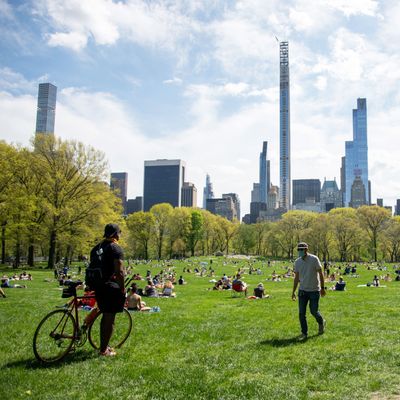
EXT. CENTRAL PARK — EARLY MORNING
The park glistens in the gold September light. Dogs chase across the freshly mowed grass. A few joggers in surgical masks and Day-Glo sneakers lumber by.
It might be an ordinary day, but the soundtrack intimates that it’s full of promise. Orchestral music rises like mist off the grass: quivering strings, a wistful clarinet, a tintinnabulation of crotales.
Wait, this isn’t a movie — it only feels like one. I pull off my headphones, and the scene reverts to the dull haze we’ve become accustomed to. Anxious thoughts and shards of preposterous news ping my pre-coffee consciousness. I overhear scraps of conversation and wish I hadn’t:
“… swabbing down groceries might be a bit much, but …”
“… now he’s got Barr going after …”
“… so she had to move back in with her parents …”
I put the headphones back on, and the world is gilded by music, which responds to my movements. I turn down a twisting track through woods, and a lush jazz ensemble accompanies me, quickening my step. I emerge into a clearing and find a solo flute waiting there, merging with the choir of birds that breaks into the soundtrack from the real world. Ellen Reid’s Soundwalk, composed for and performed by the New York Philharmonic, is an interactive glamorizing machine. A harp trembles or a solo cello unfurls a noble tune, and a mere walk in the park turns into a journey, a philosopher’s amble, a romantic jaunt.
These are tough times for symphony orchestras, which belong in the forbidden indoors. The richness of their timbre depends on walls to ricochet off, and old wooden instruments creak when the air is too moist for too long. It will be months — three, eight, 24? — before they and their audiences can return to their natural habitat, and over the summer, even the Philharmonic’s annual excursion out of doors were scrapped: no blankets, no picnics, no tinny Tchaikovsky floating off over the ball fields.
So the orchestra is doing what it can, dispatching small commando units of musicians around the city on a pickup truck to perform impromptu concerts for audiences of not-too-many-and-not-too-close-together-please. And it commissioned and recorded Reid’s portable ode to Central Park, playable on an app that knows where you are and tailors the experience to your route on the fly. It might have been a gimmick, nothing more than a silly update to the personalized playlist. Instead, it’s a work that’s found its ideal form. While most of the classical-music audience makes do with livestreamed concerts or old recordings, Reid has written a piece that can only be heard in private and in motion, with an obliging orchestra tracking the listener’s steps.
She is a talented composer with a feel for the subtle relationship between physical and musical landscapes. Countless composers have conjured places in notes, directing the imagination to the top of a mountain range, the bottom of the Rhine, or Central Park in the Dark. John Luther Adams blends the sounds musicians produce with those that the world is bound to contribute in an outdoor performance. But Soundwalk is at once open-ended and rigorous, glossy and improvisational. Reid creates a rich, grandly orchestral sound world of intimate nuzzlings and wraparound vistas, but she also uses GPS as a structural tool, shuffling sections like cues in a movie soundtrack and letting the listener’s trajectory shape the score rather than the other way around.
The result emulates an immersive VR session: When you turn, so does the music. But the response is smooth and slow, not instantaneous, so that you’re only gradually aware of the shifts, and the experience never fragments into nonsense. Though you hear one music if you enter the park at Columbus Circle and another if you start at Harlem Meer, those differences are subsumed into a cogent whole, unified by a slow, ambling pulse and short motifs woven into sections that can segue or repeat without tearing the texture of the whole. The park itself is like that, always the same and ever changing, a setting for whatever dramas or comedies we choose to play out in its embrace. Borrowing from the theatricality of Olmsted’s design, with its shaded culverts and broad meadows, Reid ennobles the humdrum and the happenstance. She grants us an illusion we all need right now: that we have the power to change the plot merely by walking in a different direction.
*A version of this article appears in the September 28, 2020, issue of New York Magazine. Subscribe Now!





